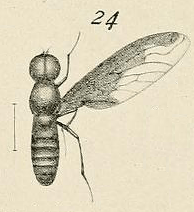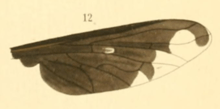Brachyanax
Brachyanax is a genus of bee fly in the subfamily Anthracinae. It was circumscribed by Neal Evenhuis in 1981. Thirteen species are recognized, and they are found in Asia and Australasia.
| Brachyanax | |
|---|---|
 | |
| Female B. aterrimus | |
 | |
| B. leucostigma wing | |
| Scientific classification | |
| Kingdom: | Animalia |
| Phylum: | Arthropoda |
| Class: | Insecta |
| Order: | Diptera |
| Family: | Bombyliidae |
| Tribe: | Anthracini |
| Genus: | Brachyanax Evenhuis, 1981[1] |
| Type species | |
| Brachyanax thelestrephones Evenhuis, 1981 | |
Taxonomic history
The American entomologist Neal Evenhuis created the genus in a 1981 paper in Pacific Insects. His initial circumscription included eleven species. Four species had first been described in the genus Anthrax; Evenhuis described the other seven species in his initial circumscription.[1] Evenhuis and Junichi Yukawa described an additional new species in 1986.[2] Further changes to the list of species in Brachyanax occurred in 1988[3] and 1999.[4]
The generic name Brachyanax comes from the Greek βραχύς (brakhús; "small, short")[5] and ἄναξ (ánax; "lord, master, general-in-chief").[6] The specific epithet of the type species, thelestrephones, comes from the Greek θηλή (thēlḗ; "nipple")[7] and στρέφω (stréphō; "twist").[8] This led to the American entomologist Arnold Menke including Brachyanax thelestrephones in his 1993 list "Funny or Curious Zoological Names"; Menke translated the binomen as "little chief nipple twister".[9] Subsequent discussions of interesting taxonomic names have also included this binomen, using the same translation.[10][11][12] The species B. thelestrephones became recognized as a junior synonym of B. satellitius in 1999.[4] However, following the International Code of Zoological Nomenclature, the type species of the genus remains Brachyanax thelestrephones.[13][14]
Phylogeny
When Evenhuis circumscribed Brachyanax, he wrote this genus was between the tribes Anthracini and Exoprosopini although more similar to the former.[1] Evenhuis and other dipterists have subsequently continued to place Brachyanax in Anthracini.[15][16][17] The other genera placed in Anthracini are: Anthrax, Dicranoclista, Satyramoeba, Spogostylum, Thraxan, Turkmeniella, Walkeromyia, and Xenox.[14]
Distribution
Brachyanax species are found in the Australasian/Oceanian realm (Australia, Indonesia, Papua New Guinea, Solomon Islands, Bonin Islands),[18] the Oriental realm (Indonesia, Philippines, Laos, India, Malaysia, Singapore,[19] possibly China), and the Palearctic realm (Japan, possibly China).[14]
Description

Males and females in the genus Brachyanax are morphologically the same except with respect to genitalia. Their body length is 3.5–11.0 mm (0.14–0.43 in) and their wingspan is 10.0–28.0 mm (0.39–1.10 in). The head is either as wide as or narrower than the thorax; the abdomen is slightly narrower than the thorax.[1]
Brachyanax species have distinctive antennae: the pedicel, or second segment, is "spherically cone-shaped" and the base of the third segment, or flagellum, is rather enlarged and bulbous.[17][1]
The wing venation is also distinctive: the radial vein R2+3 originates near the r-m crossvein and gently curves 90° to the wing's margin. The radial veins R2+3 and R4 both lack an appendix, or spur-vein, at their base.[17][1] The anal cell, or cell cup, is closed, typically with a short stalk. The basal portion of the wing is an opaque dark brown; this can cover one-third to four-fifths of each wing's area. The remainder of the wing is colourless and transparent. Its squamae and squamal fringe are brown to dark brown.[1]
Species
In 2015, Evenhuis and D. J. Greathead recognized the following thirteen species in Brachyanax:[14]
- B. acroleucus (Bigot, 1892)[20][4]
- B. ater (Roberts, 1928)[21][3]
- B. aterrimus (Doleschall, 1858)[22][3]
- B. bifuscatipennis (Evenhuis & Arakaki, 1980)[23][1]
- B. chichijimensis Evenhuis, 1981[1]
- B. costalis Evenhuis, 1981[1]
- B. gentilis (Brunetti, 1909)[24][3]
- B. hemipenthes Evenhuis, 1988[3]
- B. leucostigma (Wulp, 1898)[25][1]
- B. magnipennis Evenhuis, 1981[1]
- B. papuanus Evenhuis, 1981[1]
- B. perniger Evenhuis & Yukawa, 1986[2]
- B. satellitius (Walker, 1856)[26][4]
References
- Evenhuis, Neal L. (1981). "Studies in Pacific Bombyliidae (Diptera) VI. Description of a new anthracine genus from the western Pacific, with notes on some of Matsumura's Anthrax types" (PDF). Pacific Insects. 23 (1–2): 189–200.
- Evenhuis, Neal L.; Yukawa, Junichi (1986). "Bombyliidae (Diptera) of Panaitan and the Krakatau Islands, Indonesia". Kontyû. Tokyo. 54 (3): 450–459.
- Evenhuis, Neal L. (1988). "Review of the Genus Brachyanax (Diptera: Bombyliidae), with a Revised Key to Species" (PDF). Bishop Museum Occasional Papers. 28: 65–70.
- Evenhuis, N. L.; Greathead, D. J. (1999). "Genus Brachyanax Evenhuis" (PDF). World catalog of bee flies (Diptera: Bombyliidae). Leiden: Backhuys. pp. 319–320.
- Liddell, Henry George; Scott, Robert, eds. (1996). "βραχύς". A Greek–English Lexicon With a Revised Supplement. Revised and augmented by Henry Stuart Jones, with Roderick McKenzie et al. (9th ed.). Oxford: Oxford University Press. pp. 328–329, S72. ISBN 978-0-19-864226-8.
- Liddell, Henry George; Scott, Robert, eds. (1996). "ἄναξ". A Greek–English Lexicon With a Revised Supplement. Revised and augmented by Henry Stuart Jones, with Roderick McKenzie et al. (9th ed.). Oxford: Oxford University Press. pp. 114, S29. ISBN 978-0-19-864226-8.
- Liddell, Henry George; Scott, Robert, eds. (1996). "θηλή". A Greek–English Lexicon With a Revised Supplement. Revised and augmented by Henry Stuart Jones, with Roderick McKenzie et al. (9th ed.). Oxford: Oxford University Press. pp. 798, S151. ISBN 978-0-19-864226-8.
- Liddell, Henry George; Scott, Robert, eds. (1996). "στρέφω". A Greek–English Lexicon With a Revised Supplement. Revised and augmented by Henry Stuart Jones, with Roderick McKenzie et al. (9th ed.). Oxford: Oxford University Press. p. 1654. ISBN 978-0-19-864226-8.
- Menke, Arnold S. (1993). "Funny or Curious Zoological Names". BOGUS. -2: 26. ISSN 1072-2556.
- "Sick puppies, chief nipple twisters and the King of gall wasps". Times Higher Education. 30 September 2005.
- Conniff, Richard (December 1996). "What's in a Name? Sometimes More than Meets the Eye". Smithsonian. Vol. 27 no. 9. pp. 66–68.
- Conniff, Richard (2009). "The Value of a Good Name". Swimming with Piranhas at Feeding Time: My Life Doing Dumb Stuff with Animals. New York: W. W. Norton. pp. 47–48. ISBN 978-0-393-07153-5.
- International Commission on Zoological Nomenclature (1999). "Types in the Genus Group". International Code of Zoological Nomenclature (4th ed.). London: The International Trust for Zoological Nomenclature. Article 67.1.2.
- Evenhuis, N. L.; Greathead, D. J. (October 2015). "Genus Brachyanax Evenhuis" (PDF). World Catalog of Bee Flies (Diptera: Bombyliidae). Honolulu: Bishop Museum. pp. 330–332.
- Evenhuis, Neal L. (1985). "The Status of the Genera of the Tribe Anthracini" (PDF). International Journal of Entomology. 27 (1–2): 162–169.
- Liu, Ningwu; Nagatomi, Akira; Evenhuis, Neal L. (1995). "Genitalia of the Japanese Species of Anthrax and Brachyanax (Diptera, Bombyliidae)". Zoological Science. 12 (5): 633–647. doi:10.2108/zsj.12.633.
- Yeates, David K.; Lambkin, Christine L. (1998). "Cryptic species diversity and character congruence: review of the tribe Anthracini (Diptera : Bombyliidae) in Australia". Invertebrate Systematics. 12 (6): 977–1078. doi:10.1071/IT97019.
- Evenhuis, Neal L. (15 April 2016). "Family Bombyliidae". Catalog of the Diptera of the Australasian and Oceanian Regions. Bishop Museum. p. 370. Retrieved 22 March 2018.
- Evenhuis, Neal L.; Greathead, David J. (2003). "World Catalog of Bee Flies (Diptera: Bombyliidae): Corrigenda and Addenda" (PDF). Zootaxa. 300 (1): 40. CiteSeerX 10.1.1.508.1305. doi:10.11646/zootaxa.300.1.1.
- Bigot, J.-M.-F. (1892). "Diptères nouveaux ou peu connus. 37e partie. XlVI Bombylidi (mihi) 1re partie". Annales de la Société Entomologique de France. 61: 349.
- Roberts, Frederick H. S. (1928). "A Revision of the Australian Bombyliidae (Diptera). Part I". Proceedings of the Linnean Society of New South Wales. 53 (216): 140–141.
- Doleschall, C. L. (1858). "Derde bijdrage tot de kennis der dipterologische fauna van Nederlandsch Indië". Natuurkundig Tijdschrift voor Nederlandsch Indië. 14: 93.
- Evenhuis, Neal L.; Arakaki, Keith T. (1980). "Studies in Pacific Bombyliidae (Diptera). IV. On some Philippine Bombyliidae in the collection of the Bishop Museum, with descriptions of new species" (PDF). Pacific Insects. 21 (4): 317–318.
- Brunetti, E. (1909). "Revised and Annotated Catalogue of Oriental Bombyliidae with Descriptions of New Species". Records of the Indian Museum. 2 (5): 449, 470–471; Pl. 12, Fig. 25.
- Wulp, F. M. van der (1898). "Dipteren aus Neu-Guinea in der Sammlung des Ungarischen National-Museums". Természetrajzi Füzetek Kiadja a Magyar Nemzeti Muzeum. 21: 419.
- Walker, Francis (1856). "Catalogue of the Dipterous Insects collected at Sarawak, Borneo, by Mr. A. R. Wallace, with Descriptions of New Species". Journal of the Proceedings of the Linnean Society of London. Zoology. 1 (3): 119. doi:10.1111/j.1096-3642.1856.tb00964.x.